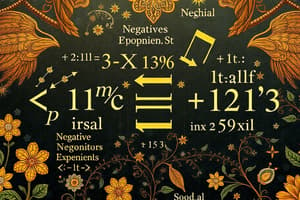Podcast
Questions and Answers
قاعدهای که میگوید هر عددی به توان منفی برابر است با چه چیزی؟
قاعدهای که میگوید هر عددی به توان منفی برابر است با چه چیزی؟
معکوس توان مثبت اصلی
قاعدهای که میگوید عبارت $(a imes b)^{-n}$ برابر است با چه چیزی؟
قاعدهای که میگوید عبارت $(a imes b)^{-n}$ برابر است با چه چیزی؟
$\frac{1}{(a imes b)^n}$
در عبارت $3x^2 + 2x^2 + 4x^3$، عبارتهای $x^2$ با هم ترکیب شده و نتیجه چیست؟
در عبارت $3x^2 + 2x^2 + 4x^3$، عبارتهای $x^2$ با هم ترکیب شده و نتیجه چیست؟
$5x^2 + 4x^3$
برای سادهسازی عبارت $4x^2y^3 \times 2x^3y$ از کدام قاعده از توانها استفاده میکنیم؟
برای سادهسازی عبارت $4x^2y^3 \times 2x^3y$ از کدام قاعده از توانها استفاده میکنیم؟
چه معادلی برای $5^{1/2}$ وجود دارد؟
چه معادلی برای $5^{1/2}$ وجود دارد؟
Flashcards are hidden until you start studying
Study Notes
Calculating Powers and Simplifying Them
Mathematically, the concept of raising numbers or expressions to a power, also known as an exponent, is a fundamental tool in solving problems and expressing relationships. Understanding and manipulating powers through various rules and techniques is crucial for mastering algebra and building a strong foundation in mathematics. In this article, we'll explore the basics of exponents, the rules of exponents, and the simplification of expressions involving powers.
Exponents
An exponent, often represented by the "^" symbol, indicates the number of times a base (the number being raised) is multiplied by itself. For example, in (2^3), the base is 2, and the exponent 3 indicates that the base is multiplied by itself three times, resulting in (2 \times 2 \times 2 = 8).
Rules of Exponents
Product and Quotient Rules
-
(a^m \cdot a^n = a^{m+n}) - The product rule states that when multiplying powers with the same base, we add the exponents.
-
(\frac{a^m}{a^n} = a^{m-n}) - The quotient rule states that when dividing powers with the same base, we subtract the exponent in the denominator from the exponent in the numerator.
Power of a Power Rule
((a^m)^n = a^{mn}) - This rule allows us to raise a power to another power by multiplying the exponents.
Zero Property of Exponents
-
(a^0 = 1) - This property states that any number raised to the power of zero is equal to one.
-
(\frac{1}{a^n} = a^{-n}) - This property states that any number raised to a negative exponent is equal to the reciprocal of the original exponent.
Properties of Negative Exponents
To simplify expressions with negative exponents, we can use the following rules:
-
(\frac{1}{a^{-n}} = a^n) - This rule states that the reciprocal of a negative exponent is equal to the original base raised to the positive exponent.
-
((a \cdot b)^{-n} = \frac{1}{(a \cdot b)^n}) - For this rule, we multiply the bases before taking the reciprocal and raising to the negative exponent.
Simplifying Expressions with Exponents
Combining Like Terms
When simplifying expressions with exponents, we combine terms with the same base and add their exponents. For example, in (3x^2 + 2x^2 + 4x^3), we combine the coefficients of the (x^2) terms and add their coefficients, resulting in (3 + 2 = 5x^2 + 4x^3).
Using the Rules of Exponents
To simplify expressions with exponents, apply the rules of exponents, such as the product and quotient rules. For instance, to simplify (4x^2y^3 \cdot 2x^3y), we use the product rule to add the exponents of the like bases, resulting in (4x^{2+3}y^{3+1} = 4x^5y^4).
Fractional Exponents
Fractional exponents allow us to raise a number to a fractional power. For example, (5^{1/2} = \sqrt{5}). The rules for fractional exponents are similar to the rules for whole number exponents, but with the exponent as a fraction.
By carefully applying the rules of exponents and understanding the concepts of negative and fractional exponents, we can utilize powers and simplify expressions involving exponents with ease. These skills are essential for many areas of mathematics, including algebra, calculus, and beyond.
Studying That Suits You
Use AI to generate personalized quizzes and flashcards to suit your learning preferences.




